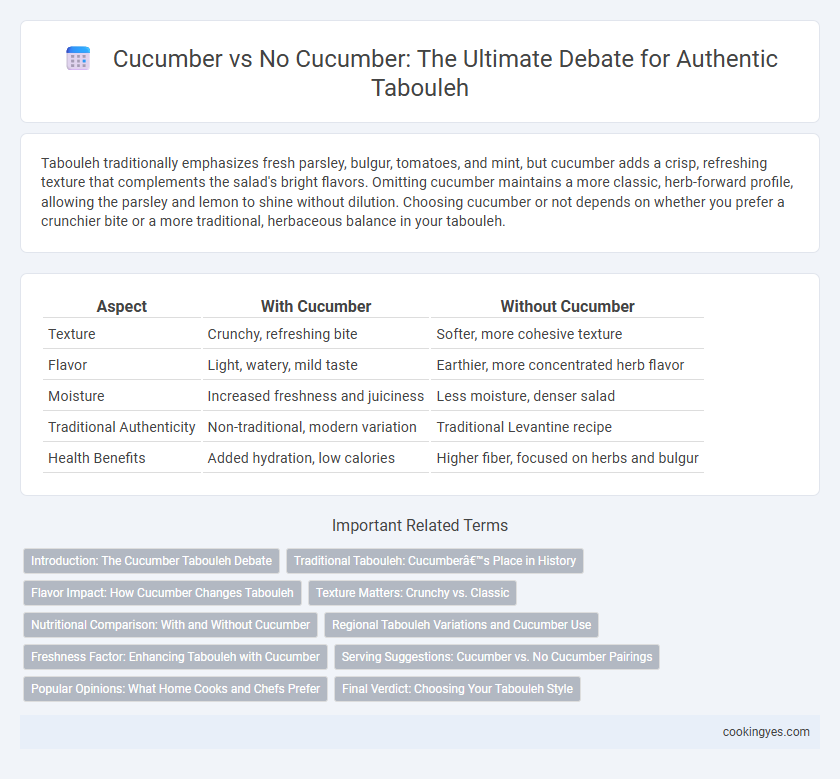Tabouleh traditionally emphasizes fresh parsley, bulgur, tomatoes, and mint, but cucumber adds a crisp, refreshing texture that complements the salad's bright flavors. Omitting cucumber maintains a more classic, herb-forward profile, allowing the parsley and lemon to shine without dilution. Choosing cucumber or not depends on whether you prefer a crunchier bite or a more traditional, herbaceous balance in your tabouleh.
Table of Comparison
| Aspect | With Cucumber | Without Cucumber |
|---|---|---|
| Texture | Crunchy, refreshing bite | Softer, more cohesive texture |
| Flavor | Light, watery, mild taste | Earthier, more concentrated herb flavor |
| Moisture | Increased freshness and juiciness | Less moisture, denser salad |
| Traditional Authenticity | Non-traditional, modern variation | Traditional Levantine recipe |
| Health Benefits | Added hydration, low calories | Higher fiber, focused on herbs and bulgur |
Introduction: The Cucumber Tabouleh Debate
Cucumber in tabouleh contributes a refreshing crunch and subtle sweetness that contrasts with the herbaceous parsley and zesty lemon. Traditional Levantine tabouleh typically excludes cucumber, emphasizing bulgur, parsley, tomato, and mint for a bright, textured salad. Preference for cucumber hinges on regional variations and individual taste, with some favoring its cooling qualities while purists maintain the original texture balance without it.
Traditional Tabouleh: Cucumber’s Place in History
Traditional tabouleh recipes prominently feature parsley, bulgur wheat, tomatoes, and mint, with cucumber notably absent in many authentic Middle Eastern versions. Historical culinary texts and Levantine cultural practices emphasize that cucumber was not part of the original tabouleh formulation, highlighting regional variations that use it as a modern addition for extra crunch and freshness. The absence of cucumber in traditional recipes underscores the salad's emphasis on herbaceous flavors and the balance of bulgur and lemon.
Flavor Impact: How Cucumber Changes Tabouleh
Including cucumber in tabouleh introduces a refreshing crispness and subtle watery sweetness, balancing the herbaceous flavors of parsley and mint. Without cucumber, the salad emphasizes the nutty bulgur and tangy lemon, resulting in a more concentrated, vibrant taste. The presence of cucumber lightens the overall profile, making tabouleh smoother and more hydrating, ideal for warm climates or as a palate cleanser.
Texture Matters: Crunchy vs. Classic
Cucumber adds a refreshing crunch to tabouleh, enhancing the salad's texture with a crisp bite that contrasts the soft parsley and bulgur wheat. Traditional tabouleh, without cucumber, relies on the tender, herbaceous flavors and delicate chewiness of soaked bulgur for a more classic, smooth mouthfeel. Choosing cucumber emphasizes textural variety, while omitting it preserves the authentic balance integral to Middle Eastern tabouleh recipes.
Nutritional Comparison: With and Without Cucumber
Tabouleh with cucumber offers added hydration and a boost of vitamin K, fiber, and antioxidants, contributing to improved digestion and heart health. Without cucumber, the salad maintains higher concentrations of parsley and bulgur, resulting in increased iron, magnesium, and protein content per serving. Choosing cucumber or omitting it slightly shifts the nutrient profile but both versions provide a refreshing, nutrient-dense dish rich in vitamins C and A.
Regional Tabouleh Variations and Cucumber Use
Regional tabouleh variations prominently influence the inclusion of cucumber, with Lebanese tabouleh traditionally excluding cucumber to emphasize parsley and bulgur flavors. In contrast, Syrian and Lebanese-American adaptations often incorporate diced cucumber, enhancing the salad's texture and adding a fresh, crisp element. Understanding these regional preferences highlights how cucumber use in tabouleh reflects diverse culinary traditions and local ingredient availability.
Freshness Factor: Enhancing Tabouleh with Cucumber
Including cucumber in tabouleh significantly enhances its freshness factor by adding a crisp, cooling texture that balances the herbaceous parsley and tangy lemon flavors. The high water content of cucumber contributes to a more hydrating and refreshing salad experience, making it ideal for hot weather or as a light appetizer. Omitting cucumber results in a drier, denser tabouleh where the bulgur and herbs dominate, reducing the overall crispness and cooling effect.
Serving Suggestions: Cucumber vs. No Cucumber Pairings
Tabouleh served with cucumber pairs exceptionally well with light proteins such as grilled chicken or fish, enhancing its refreshing and crisp flavor profile. Without cucumber, traditional tabouleh complements hearty dishes like roasted lamb or rich stews, allowing the herbaceous notes of parsley and mint to stand out. Offering tabouleh with or without cucumber can be tailored to the meal, matching the salad's texture and taste to the main course for optimal flavor balance.
Popular Opinions: What Home Cooks and Chefs Prefer
Home cooks and chefs often debate the inclusion of cucumber in tabouleh, with traditional Middle Eastern recipes favoring parsley, bulgur, tomatoes, and mint without cucumber. Many chefs argue that cucumber can dilute the vibrant flavors and alter the classic texture, while some home cooks prefer cucumber for added freshness and crunch. Popular opinions vary by region and personal taste, but authentic tabouleh typically excludes cucumber to maintain its herb-forward profile.
Final Verdict: Choosing Your Tabouleh Style
Tabouleh with cucumber offers a refreshing crunch and adds subtle hydration, enhancing the salad's texture and flavor complexity. Traditional tabouleh without cucumber emphasizes the herbaceous notes of parsley and mint, maintaining classic authenticity with a more vibrant lemon and olive oil balance. Selecting cucumber or not depends on personal taste preferences--choose cucumber for a modern twist or omit it for a timeless, herb-forward tabouleh experience.
Cucumber vs No Cucumber for Tabouleh Infographic

 cookingyes.com
cookingyes.com